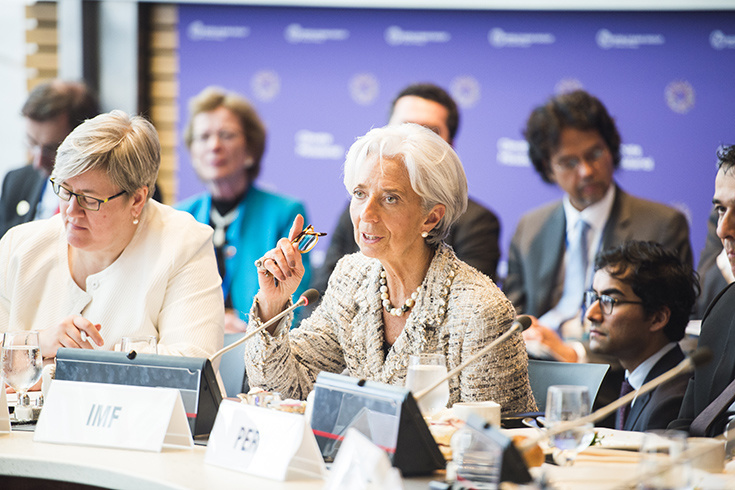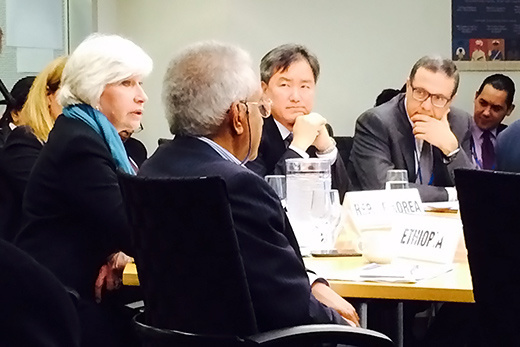News Release from windfair.net
Wind Industry Profile of
Mobilizing the Billions and Trillions for Climate Finance
Putting a price on carbon and phasing out fossil fuel subsidies are two ways governments can free up and increase public funds. Other sessions looked at the roles development banks and central banks can play in encouraging greater investment in low-carbon growth.
Across a wide range of meetings on the many aspects of financing the transition to low-carbon, resilient growth, three points made this IMF/World Bank Group Spring Meetings different: They were standing room only, they reflected the growing sense of purpose and urgency, and they brought together voices from all areas of the economy – governments, central banks, development institutions, businesses, investors, and communities.
The climate ministerial reflected all three as 42 ministers of finance and development met with the heads of the World Bank, IMF, and United Nations and business and investment leaders to discuss meeting the world’s climate finance needs and how carbon pricing can lower emission and raise public funds for clean, resilient development.
Other meetings peeled back the ways central banks could encourage low-carbon investment and discussed how long-term targets for renewable energy and energy efficiency and policy packages, including fossil fuel subsidy reform, can direct investment to cleaner sources. All pointed to the need for clean, low-carbon growth and ways to lower emissions and increase climate finance.
“In less than nine months, climate negotiators will be in Paris to finalize an international agreement to reduce greenhouse gas emissions and begin slowing the impacts of climate change. Their success will depend heavily on how leaders, many of them here for the Spring Meetings, shape economic policies and catalyze climate finance to respond to the risks of our rapidly warming planet,” World Bank Group President Jim Yong Kim told the public and private sector guests at a meeting on climate finance co-hosted with the European Investment Bank.
The magnitude of the challenge
Over the next 15 years, the global economy will require an estimated $89 trillion in infrastructure investments across cities, energy, and land-use systems, and $4.1 trillion in incremental investment for the low-carbon transition to keep within the internationally agreed limit of a 2 degree Celsius temperature rise.
In addition, developed countries are working to meet a commitment made in 2010 to mobilize $100 billion a year from public and private sources by 2020 for climate mitigation and adaptation in developing countries. Showing the pathways to that $100 billion commitment will be important for building trust and confidence around the Paris climate negotiations that are expected to produce a new international agreement later this year.
Carbon pricing and fossil fuels
Putting a price on carbon and phasing out fossil fuel subsidies are two ways governments can free up and increase public funds. With a small percentage of the money that saved by ending subsidies or of the revenue raised from a carbon tax or permit sale going to climate finance, governments could help meet the $100 billion climate finance commitment and other mitigation and adaptation needs.
In the climate ministerial, led by World Bank Group President Kim, IMF Managing Director Christine Lagarde and United Nations Secretary-General Ban Ki-moon, U.S. Treasury Secretary Jacob Lew and ministers from China, India, Brazil, South Africa and other countries heard from CEOs, who explained how a stable carbon price can incentivize cleaner decisions and innovation, and from British Columbia Premier Christy Clark, whose province has a revenue-neutral carbon tax that has lowered income and businesses taxes and has a credit to help offset costs for the poor.
Several of the ministers raised concerns about the need to get finance flowing. Others discussed the value of carbon pricing in fueling innovation and lowering greenhouse gas emissions.

IMF Managing Director Christine Lagarde addresses the climate ministerial at the IMF/World Bank Group Spring Meetings.

Laurence Tubiana, special representative of the French Minister of Foreign Affairs for the 2015 Paris Climate Conference (COP21) and French ambassador for climate negotiations, speaks at a meeting on carbon pricing organized by the Swedish government.
Earlier in the day, Sweden’s Finance Minister Magdalena Andersson described to another packed room of government officials and leaders from business and civil society how her country had implemented a high carbon tax tailored to their economy and, over time, had decoupled growth from emissions.
“It has made Sweden a driver of economic growth and efficiency,” Andersson said. “You can combine steady economic growth with a reduction of greenhouse gases.”
Friends of Fossil Fuel Subsidy Reform, a coalition of eight countries, was joined by France in taking on another potential source of climate finance and greenhouse gas reductions: the group released a communique calling for the phase-out of subsidies in the lead-up to the Paris conference, arguing that the harmful subsidies encourage waste and disproportionately benefit wealthier households. The nearly $550 billion a year spend on fossil fuel subsidies can be reallocated for better public use, including climate finance for sustainable development.
Central banks
On the larger question of economic transformation, the UNEP Inquiry led a discussion on “a quiet revolution” underway to redesign financial systems for low-carbon growth. Financial regulators, standard-setters, and banks are rethinking the rules governing financial systems from a sustainability perspective, the speakers said.
Ma Jun, chief economist of the People’s Bank of China, offered a snapshot of some of the innovations being discussed in China as the country drafts its 13th Five-Year Plan. In the next five years, he said, China will need about 2 trillion yuan (US$322 billion) in annual investment. The fiscal system can meet about 15 percent of that, he said, leaving a large percentage to be filled by the private sector.
China is discussing greater use of green bonds, discounted loans for climate-friendly projects, the development of green banks and green funds, and it has seven pilot carbon markets and plans to launch a national carbon market as early as 2016. The chief economist suggested that public-private partnership financing could help increase the participation of the private sector in infrastructure projects.
Private investment
The meetings reflected a growing understanding in the private and public sectors of the risks that climate change poses to supply chains, business assets, and society at large. Investors, particularly long-term investors like pension funds, which were represented at the meetings, have been increasing pressure on companies to shift toward cleaner investments and avoid high-emitting assets that could become stranded in an economy evolving away from fossil fuels.
Atiur Rahman, governor of Bangladesh’s central bank, told the EIB-World Bank event that he sees mindsets changing in the country’s banks and increasing support for green projects. One driver, he said, has been leadership since the central bank began to focus on climate impact.
Stranded assets pose another risk flagged by investors in several sessions, including Carbon Tracker’s discussion of the limits to how much of the world’s fossil fuel reserves can be burned and still keep the planet from warming more than 2 degrees Celsius and what that means for the construction of power sources today.
The magnitude of the finance challenges ahead and the discussions made clear the need to build on one another’s work and set targets, said World Bank Group Vice President and Special Envoy for Climate Change Rachel Kyte. “One thing that came through very clear is that you have to know where you're going. You have to have clear goals and targets at the national level,” Kyte said. Shifting the world to a cleaner trajectory will require nothing short of economic transformation.
- Source:
- Worldbank
- Link:
- www.worldbank.org/...
